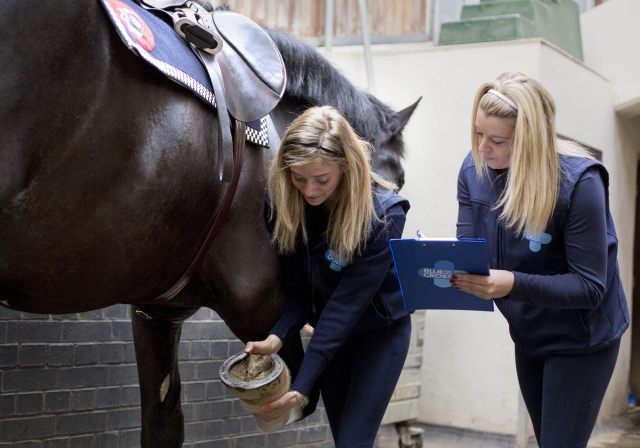
Limbs Not Feet Are Main Cause Of Lameness Reveals Horse Survey
We are all familiar with the old adage ‘no foot, no horse,’ but the results of the latest National Equine Health Survey (NEHS) show that lameness is three times more likely to be caused by conditions such as osteoarthritis in the limb rather than problems in the foot. The results are consistent with previous NEHS survey findings, showing evidence rather than opinion is now being generated by report, helping owners and experts to understand and improve the health of the country’s 944,000 horses.
Blue Cross runs NEHS in May each year, in partnership with the British Equine Veterinary Association (BEVA). It is sponsored by SPILLERS and Zoetis and supported by the UK’s leading equestrian organisations and charities. This year saw a 35% increase in participation compared to 2014, with survey records returned for almost 15,000 horses, ponies, donkeys and mules.
The horse’s foot is fundamental to soundness and performance but NEHS results have shown consistently that limb lameness, as opposed to foot lameness, is in fact the biggest syndrome affecting horses. In the latest survey, conducted in May, a total of 18% were recorded as lame. 13.5% of these were recorded as suffering with lameness such as osteoarthritis, also known as degenerative joint disease (13.9% in 2014 and 14.8% in 2013). Meanwhile foot lameness was recorded in 4.5% of returns, a similar figure to previous years.
Josh Slater from the Royal Veterinary College, who is member of BEVA’s Health & Medicines Committee and analysed the NEHS data, said: “NEHS is now producing important evidence that is replacing subjective opinion. While the lameness figures were initially surprising, given that the foot has been generally regarded as the main problem area, the fact that these figures have remained consistent over the past three years gives constructive credibility to the data. Our findings will help owner vigilance with day-to-day healthcare as well as help prioritise on areas for future veterinary education and research.”
The six most notable disease syndromes identified in the 2015 National Equine Health Survey are consistent with findings over previous years:
1. Lameness 18% with 13.5% having limb lameness such as osteoarthritis (degenerative joint disease) not relating to the foot, compared to 14.8% in 2014, 14.8% in 2013 and 9.3% in 2010-12 and 4.5% with foot lameness compared to 4.6% in 2014, 3.8% in 2013 and 4.5% in 2010-12.
2. Skin diseases 17.2% (sweet itch, mud fever and external parasites) compared to 18.3% in 2014, 14.6% in 2013 and 15.2% in 2010-12.
3. Back problems 7% compared to 7.7% in 2014, 5% in 2013 and 3% in 2010-12.
4. Recurrent Airway Obstruction 6.7% was the most frequently recorded respiratory problem, compared to 6.9% in 2014, 4.2% in 2013 and 3.6% in 2010-12.
5. Laminitis 6.4% compared to 7.1% in 2014, 4.4% in 2013 and 3.6% in 2010-12.
6. PPID (‘Equine Cushing’s Disease) 6.4% confirmed or suspected compared to 5.6% in 2014, possibly reflecting increased surveillance through sponsored testing programmes as opposed to true increases in prevalence from the pre-2014 surveys.
23.2% of horses were reported as being overweight with a Body Condition Score of 3.5-5, continuing the upward trend seen in previous years (16.9% in 2014 and 7.8% in 2013). Next year’s survey will explore links between obesity and the possible associated rise of obesity-related diseases such as equine metabolic syndrome (which was reported in 2.4% of 2015 returns) and laminitis.
The Survey also enables participants to report on any health problems not covered in the survey questions, giving them a chance to shape future survey subjects.
Gemma Taylor, Education Officer at Blue Cross explains: “This year 11% of our free text answers mentioned gastric ulcers giving a valuable insight into the prevalence gastric ulcer syndrome in the principally leisure horse NEHS population. As a result we will be adding new questions to the 2016 survey to help us find out more.”
Further news on the important findings of this year’s NEHS will be disclosed as it becomes available. The 2015 NEHS survey results are now available. To download a copy visit http://www.bluecross.org.uk/nehs2015results and to register for next year’s survey please visit www.bluecross.org.uk/nehs
More from The Blue Cross
- Over 2,000 cats and dogs sterilised to avoid surge in strays in war-torn Ukraine
- Blue Cross publishes new ‘Mary King approved’ practical horse care guides
- Fur-ever in our hearts: Battersea volunteer pays tribute to sweet one-eyed ‘celebrity’ rescue dog
- Blue Cross urges struggling horse owners to ask for help sooner rather than later
- Loving new home for horse who was cruelly set alight during fight

 9 years ago
9 years ago  1119 views
1119 views

 11 hours ago
11 hours ago